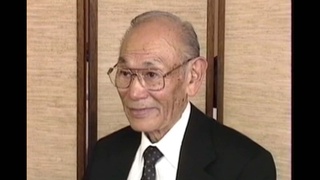Interviews
Participating in military drills in school in Japan during the war
In the mornings we would strip down, have a white top on with the monpe (female loose work pants) on and we'd have the teams, red, the hachimaki (headband) and it was a kind of a drill that we had. It was cold, it happened to be, I remember it was cold. We all had a bamboo stick and as the commands were called out we would go forward, forward, mae, mae. Meaning, and then we were told that when the shinchuu, Amerika-no shinchuugun (Ameircan Occupation Forces) comes, you know, dosuruka (what should we do?). So we would go forward, forward, and we were told, they didn't come out to say that we would be raped or whatever, but that's kind of the thing they were preparing us for.
Date: August 3 & 4, 2003
Location: Washington, US
Interviewer: Alice Ito
Contributed by: Denshō: The Japanese American Legacy Project.





